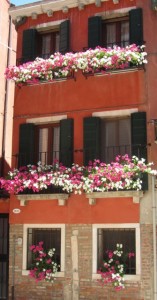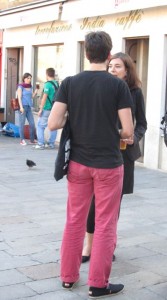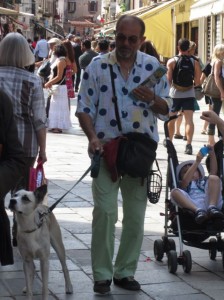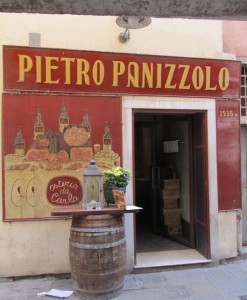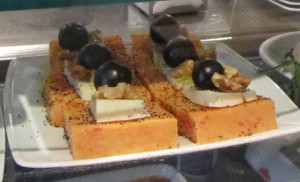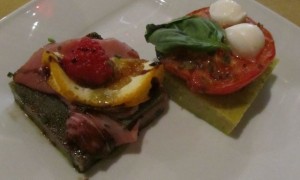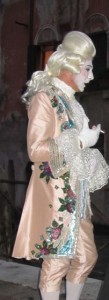Ready to Wear…and Eat
When I refer to bright shades of red, orange, purple, and pink I’m not describing the flowers blooming in window boxes all over Venice, but rather the colors of Italian men’s pants. Add a pair of lime green and sky blue and you have their complete collection of summer wear.
“It’s red, not pink,” a Scottish friend once declared after I commented on the color of his shirt.
“Well, actually it’s almost fuchsia,” I countered, not realizing the severity of my words. “Pink, scarlet, salmon, peach…really, what difference does it make?”
“Pink is for puffers, and I’m not a puffer,” he assured me with a growing temper.
Obviously, Scottish, and most likely American men have something to learn from the Italians. Canary yellow, a bold lavender, nothing is out of their range. Throw in some espadrilles and thick white-rimmed glasses and you still have a real man, his masculinity completely intact. (Most likely this board generalization doesn’t apply to dock workers and underlings in the mafia.)
“But does this concept also apply to polenta?” I asked myself when I came across squares of thick corn mush disguised in charcoal grey, muted crimson, and pale forest green.
“Che Bello!” I raved to the lady behind the counter at Osteria da Carla*, congratulating her on her creative (never seen before) “cicheti” display. Plates of colorful hors d’oeuvres filled the front of the restaurant, enticing eaters inside. She explained to me that the black color came from squid ink, the red from pureed tomatoes, and the green from pesto. The different ingredients were blended into pots of traditional polenta and then spread out onto baking sheets to harden. Later they were sliced and topped with inviting combinations: smoked salmon with a drizzle of orange flavored balsamic and raspberries; slices of brie with grilled zucchini; prosciutto with fresh ricotta; pears with Gorgonzola, and the traditional Caprese–tomato, mozzarella, and basil–easy, quick hors d’oeuvres even for a beginner.
When I asked a friend if she made flavored polenta her eyes widened with surprise. “I’ve never heard of such a thing,” she declared.
“I saw it yesterday at a restaurant,” I assured her. “It was for the cicheti.”
“Impossible. We Italians don’t do such things.”
“Well…”
“No. It must be an American invention.” And that was the end of the conversation.
Later I quizzed an experienced home cook about the “novel” concept and she assured me polenta was either yellow or white. There were no other alternatives.
“But what if you roast and puree beets and add them to the mixture for a stunning, flavorful magenta?”
“Impossible. It’s just not done.”
So, here’s my burning question: If Italians can be so bold with their pants, not ashamed to wear bright pink and Sunkist orange, why can’t they more readily embrace colored polenta?
*Osteria da Carla is a haven near St. Marks for anyone who loves to eat. This area is normally overrun with expensive, mediocre places, but Carla is the real deal. Tucked in an alleyway, off the main streets, she still serves workers and gondaliere, some of the same clientele she started with forty years ago…but now with a little fancier food.
Pesto Polenta Squares
1 cup polenta
1/2 cup prepared pesto
1/4 cup grated Parmesan cheese
1/4 cup heavy cream
salt and pepper to taste
1. Fill a medium sized stockpot with 3 cups of water. Cover and bring to boil over high heat.
2. When water starts to boil, reduce to medium heat. Add all the ingredients and stir until well blended and thickened, about 2-3 minutes.
3. Pour the polenta onto a 9 x 12 buttered baking sheet. Spread until smooth with a spatula or knife. Let sit until completely firm (can even be made a day ahead).
4. Cut polenta into small squares or diamonds.
5. Top with just about any combination of salumeria, cheeses and roasted vegetables.
Tags: delicious expeditions, kris rudolph, osteria da Carla venice, pesto polenta recipe, polenta, polenta squares recipe, venice, venice expat blog

